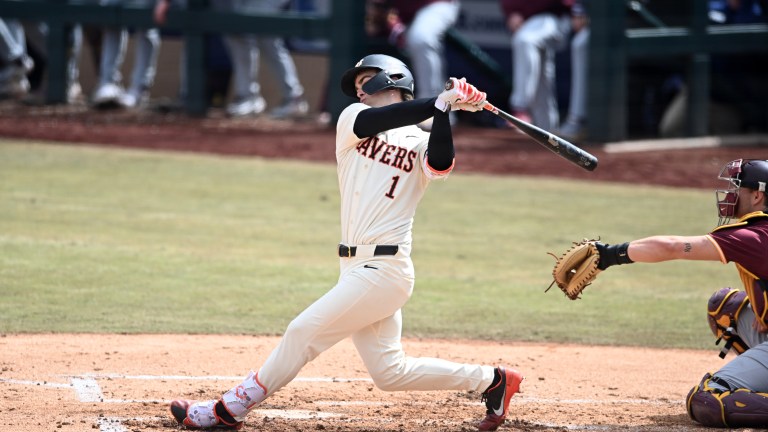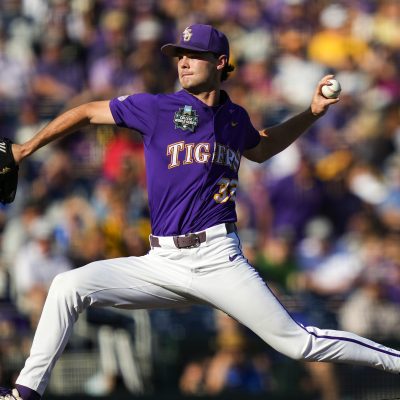Under-the-Radar College Talent on the Just Baseball Top 300 Draft Board
As all 30 teams compete to find the best talent in the draft class, these hidden gems will be important names to keep an eye on.

We’ve almost made it, ladies and gentlemen. The 2025 MLB Draft is less than a week away, and draft boards all across the country are taking shape. This comes after the conclusion of an electric college baseball season that saw many players truly put themselves in the spotlight, shooting up the rankings.
From all conferences, players around the nation came into the season looking to make an impact and increase their stock. Many of them succeeded, and they’ve made it glaringly obvious that they’re among the best talents in the class.
However, with any draft, there are always some sleepers and hidden gems. With the top-heavy nature of this year’s class, this has never been more accurate. Due to the talent in the first few rounds, many players outside of this range have fallen under the radar of scouts and fans alike.
Knowing this makes trying to find these hidden gems even more enjoyable, as all 30 teams compete to find the best talent in the class. Without further ado, let’s meet some of these players.
Charles Davalan, 2B/OF, Arkansas
After making it the whole way to the semifinal round of the College World Series with the Arkansas Razorbacks, Charles Davalan catapulted himself to the top of draft boards with ease. The 5’9″, 190-pound leadoff hitter was the staple of an offense that included the winner of the Golden Spikes Award, Wehiwa Aloy.
To put it simply, Davalan raked all season long, as the 21-year-old slashed .346/.433/.561 with 14 homers and a 121 wRC+ across 65 games. He also hit lefties very well in the process, posting great numbers against them overall. Notably, Davalan also walked more than he struck out, which really spoke to his plate discipline skills.
Davalan boasts one of the most complete bats in the entire draft, specifically when it comes to his contact profile. He posted a contact rate of over 90%, which included rates of up to 94% on pitches inside the zone. In addition to this, Davalan had an 85% contact rate against pitches at 92 mph or higher. If he maintains this, we could be looking at a 70-grade hit tool.
He’s a little limited power-wise due to his height, but that wasn’t much of an issue for him in college. At the rate he hit at Arkansas, he was projected to hit over 30 homers. While this isn’t a realistic projection, he could still post average to above-average power numbers at the next level.
While we have Davalan currently ranked as the 29th-best prospect on our top 300, he could realistically be picked at any point across a huge range. One thing is for certain, though: Whoever drafts him will be getting one of the best hit tools in the class.
Korbyn Dickerson, OF, Indiana
When taking a look at Indiana’s outfield ahead of this year’s college season, most eyes were on left-hander Devin Taylor. This made sense, as Taylor is a projected first-rounder.
However, it was another outfielder who burst onto the scene, as Korbyn Dickerson catapulted himself up draft boards during the 2025 college season. He currently ranks 46th on our top 300, but could go much higher on draft day.
Standing at 6’1″, 205 pounds, Dickerson’s frame is made for elite athleticism, which will help him stick in the outfield moving forward. He was fantastic offensively this season, slashing .314/.381/.632 with 19 homers and a 123 wRC+ in 56 games. In just this short season, Dickerson put himself in second-round conversations.
His swing is smooth and direct to the baseball, allowing for his power to play up as he moves forward. He won’t be overwhelmed with high velocity either, as his stride is calm and collected. This has led to him hitting more balls in play and whiffing less.
He nearly reached 117 mph exit velocities this season, which again, really shows just how much power is inside his bat. When I saw Dickerson play earlier this spring at Penn State, I was very impressed with just how hard the ball came off his bat regularly.
To recap, Dickerson has one of the better overall bats not currently ranked inside the first round, with his power and contact refinements allowing him to rake this season. He’ll play a very good outfield, running down balls all over the grass.
It’s not entirely impossible for Dickerson to find a home late in the first round, but if he doesn’t, he’ll be one of the steals of the draft for a team picking in the second or third round.
Cam Leiter, RHP, Florida State
Despite an injury taking away all of Cam Leiter’s 2025 season and much of his 2024 season, the right-hander remains one of the more interesting arms in this year’s draft. When healthy, he’s flashed elite stuff; the only issue is just how little of it we’ve seen in his college career.
Leiter, our 149th-ranked draft prospect, features an electric four-pitch mix. His four-seamer has been capable of reaching the high 90s, alongside elite extension.
He also offers an elite slider, which has tunneled really well off the four-seamer. His curveball and changeup have both floated around average territory but could get a little boost because of how well he tunnels all of his pitches.
Although we haven’t seen Leiter throw many college innings, the only real concern to be had about him is his control. He walked nearly 14% of batters during the little action he saw in the 2024 season, which could be a concerning sign.
Due to the sheer amount of potential in his game, Leiter may opt for another year at Florida State to get more innings and experience under his belt. If he does, this could be a wise decision. However, if he decides to go the MLB draft route this year, he could soon become a very good arm for whoever selects him.
Paxton Kling, OF, Penn State
When looking through our top 300 draft prospects, it’s difficult to find a collegiate player with as interesting of a path as Penn State outfielder Paxton Kling. Kling, a former top draft prospect out of high school, decided to forego the MLB Draft for LSU, but that didn’t exactly go to plan.
After winning a National Title with them in 2023, Kling battled injuries the following season, nearly losing his place on the team in the process. To help try to salvage his stock, our 256th-ranked prospect transferred to Penn State, where he did just that.
Across 56 games for the Nittany Lions, Kling slugged 13 homers and slashed .358/.470/.632 with 15 steals and a 151 wRC+. He did this while completely redeveloping his swing, becoming far more direct through the baseball with his barrel.
Another part of Kling’s game I noticed when watching him in person is that his glove is one of the best in this year’s class. It’s legitimately one of the best tools in his game, as his speed gives him the ability to run down balls hit deep into the gap. Not only this, but his arm is also fantastic.
Kling does have a tendency to whiff often, but it’s not something I see being a huge negative moving forward. He only struck out 16.7% of the time, all while commanding the box in the process.
Based on our ranking, Kling would likely be a ninth-round selection. If a team can grab him anywhere around that range, he could be a great value pick.
Ben Abeldt, LHP, TCU
When it comes to relievers in the MLB Draft, they’re often difficult to project, as their limited number of games can sometimes skew their stats. Teams also often favor stuff over these results, making relievers a total toss-up. However, when it comes to TCU reliever Ben Abeldt, his success feels clearer to project.
As if it weren’t hard enough to hit lefties as it is, Abeldt throws from a really awkward release, making him nearly impossible to hit. For lefty batters, he releases the ball behind them, almost throwing off the left side of the mound. Same-handed hitters struggle against him, and it’s easy to see why with his release point.
Abeldt dominated in 44.1 innings out of the bullpen this year for TCU. He pitched to a 1.83 ERA, striking out nearly 30% of the batters he faced. He allowed just one homer all season as well, something that will help him stick out even more.
He comes with a three-pitch mix that includes a mid-to-high-90s fastball, a devastating slider, and a very good changeup. While it may not be his best pitch on paper, his slider is virtually untouchable for lefties given his release point, making it an easy strike-stealer when needed.
Abeldt stranded 83% of runners this year, contributing even further to his closer profile.
While he may not be as flashy as a dominant ace, Abeldt could be a steal later in the draft. He’s ranked as our 274th-best draft prospect, meaning he’ll likely be a ninth-round steal.
Gavin Turley, OF, Oregon State
After being drafted late in the 2022 MLB Draft by the Arizona Diamondbacks, Turley elected to go the college route, heading to Oregon State. In his three seasons with the Beavers, Turley became a star and now has another chance to pursue his MLB dream this year.
Turley hit very well this season with the Beavers, even becoming a walk-off hero during the College World Series. In 65 games, he hit 20 homers and slashed .351/.472/.649 with a 155 wRC+.
He has some of the best tools outside of the first round in this year’s class. His power has 30-homer potential at the next level, as his 20 homers in 65 games this season were a good representation of his pop. While he still has some work to do to refine his hit tool, it’s possible this comes with time.
Defensively, Turley has a good arm, which, when paired with his speed, gives him plus tools in the outfield. He’ll likely land in a corner due to his arm, but his pure athleticism gives him the ability to play center field occasionally.
We currently have Turley ranked 116th on our top 300, which would make him a great fourth-rounder for any team willing to take a chance on him.


